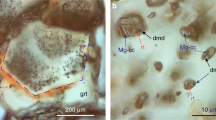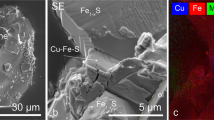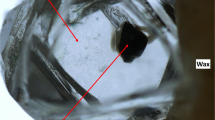Abstract
SHOCK-PRODUCED diamond and lonsdaleite (the hexagonal polymorph) were first observed in experiments involving explosions1. Several classes of meteorites2,3 contain microcrystalline diamond aggregates that are thought to be produced by impacts with the Earth or in space. Diamonds have also been found in association with several Russian impact craters4 and in Cretaceous/Tertiary boundary impact ejecta5,6; these too have most often been interpreted as having formed by shock in the solid state4. Here we report the occurrence of diamond lonsdaleite plates and cubic diamond in association with silicon carbide, in impact melts from the Ries crater in southern Germany. We interpret these occurrences as evidence that these phases can be formed by chemical vapour deposition from the ejecta plume of an impact crater. It follows that cubic diamond and silicon carbide may be formed at any impact site from vaporized carbon-bearing rocks, and hence may be used as a reliable diagnostic tool for hypervelocity impact on Earth. This process may also explain the occurrence of diamonds found in sediments (carbonados7), which may result from the 'heavy bom-bardment' period of early Earth history, rather than from mantle-derived diatremes8.
This is a preview of subscription content, access via your institution
Access options
Subscribe to this journal
Receive 51 print issues and online access
$199.00 per year
only $3.90 per issue
Buy this article
- Purchase on Springer Link
- Instant access to full article PDF
Prices may be subject to local taxes which are calculated during checkout
Similar content being viewed by others
References
DeCarli, P. S. & Jamieson, J. C. Science 133, 1821–1822 (1961).
Lipschutz, M. E. & Anders, E. Geochim. cosmochim. Acta 24, 83–105 (1961).
Vdovykin, G. P. Space Sci. Rev. 10, 483–510 (1970).
Masaitis, V. L. Meteoritics 27, 21–27 (1992).
Carlisle, D. B. & Braman, D. R. Nature 352, 708–709 (1991).
Gilmour, I. et al. Science 258, 1624–1626 (1992).
Ozima, M., Zashu, S., Tomura, K. & Matsuhisa, Y. Nature 351, 472–474 (1991).
Smith, J. V. & Dawson, J. B. Geology 13, 342–343 (1985).
Rost, R., Dolgov, Y. A. & Vishnevskiy, S. A. Dokl. Acad. Nauk. USSR 241, 165–168 (1978).
Koeberl, C. et al. Lunar planet. Sci. 26, 777–778 (1995).
El Goresy, A. & Donnay, G. Science 161, 363–364 (1968).
Pillinger, C. T. Phil. Trans. R. Soc. Lond. A 343, 73–86 (1993).
Anders, E. & Zinner, E. Meteoritics 28, 490–514 (1993).
Hough, R. M., Wright, l. P., Pillinger, C. T. & Gilmour, I. Lunar planet. Sci. 26, 629–630 (1995).
Craig, H. Geochim. cosmochim. Acta 12, 133–149 (1957).
Swart, P. K., Grady, M. M. & Pillinger, C. T. Meteoritics 18, 137–154 (1983).
Russell, S. S. & Pillinger, C. T. J. chem. Soc., Faraday Trans. 89, 2297–2304 (1993).
Yagi, T., Utsumi, W., Yamakata, M., Kikegawa, T. & Shimomura, O. Phys. Rev. B46, 6031–6039 (1992).
Berger, S. D., Mckenzie, D. R. & Martin, P. J. Phil. Mag. Lett. 57, 285–290 (1988).
Masaitis, V. L. Regionalaia Geologia i Metallogenia 1, 121–134 (1993).
Heimann, R. B. & Kleiman, J. in Crystals: Growth, Properties and Applications (ed. Freyhardt, H. C.) 1–76 (Springer, Berlin, 1988).
Sato, Y. & Kamo, M. in The Properties of Natural and Synthetic Diamond (ed. Field, J. E.) 423–469 (Academic, London, 1992).
Varshavskii, A. V. & Shul'pyakov, Y. F. Soviet Phys. Dokl. 12, 202–204 (1967).
Yamada, K. & Tobisawa, S. Phil. Mag. A61, 943–954 (1990).
Kalnin, A. A., Neubert, F. & Pezoldt, J. Diamond Related Mater. 3, 346–352 (1994).
von Engelhardt, W., Luft, E., Arndt, J., Schock, H. & Weiskirchner, W. Geochim. cosmochim. Acta 51, 1425–1443 (1987).
Author information
Authors and Affiliations
Rights and permissions
About this article
Cite this article
Hough, R., Gilmour, I., Pillinger, C. et al. Diamond and silicon carbide in impact melt rock from the Ries impact crater. Nature 378, 41–44 (1995). https://doi.org/10.1038/378041a0
Received:
Accepted:
Issue Date:
DOI: https://doi.org/10.1038/378041a0
This article is cited by
-
Natural and experimental high-pressure, shock-produced terrestrial and extraterrestrial materials
Progress in Earth and Planetary Science (2021)
-
Microstructural constraints on the mechanisms of the transformation to reidite in naturally shocked zircon
Contributions to Mineralogy and Petrology (2017)
-
Nanosecond formation of diamond and lonsdaleite by shock compression of graphite
Nature Communications (2016)
-
Natural occurrence of pure nano-polycrystalline diamond from impact crater
Scientific Reports (2015)
Comments
By submitting a comment you agree to abide by our Terms and Community Guidelines. If you find something abusive or that does not comply with our terms or guidelines please flag it as inappropriate.



